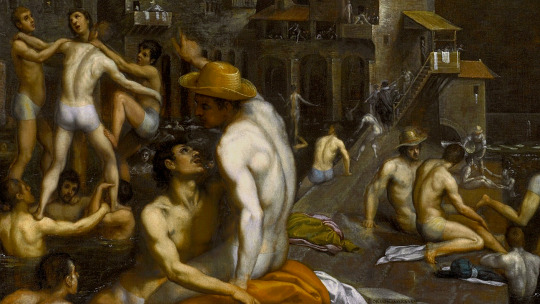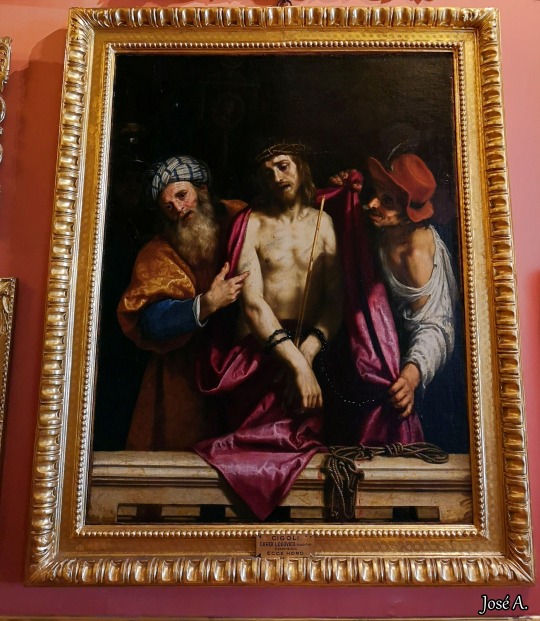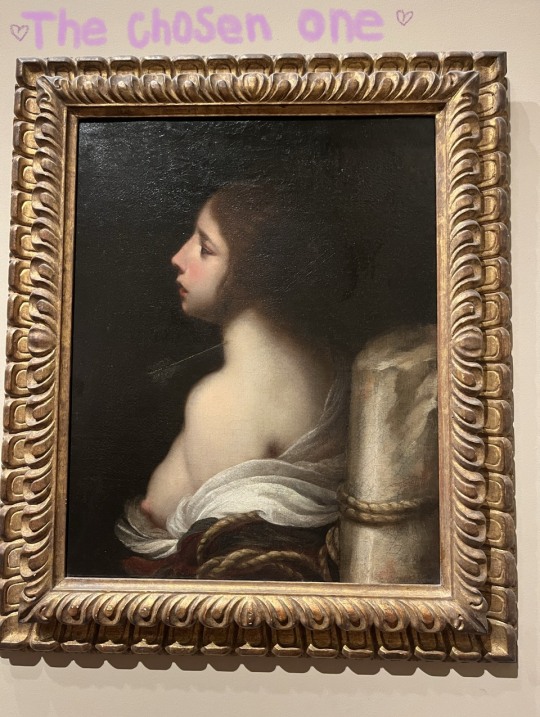#Domenico Passignano
Explore tagged Tumblr posts
Text

Domenico Passignano (1559 – 1638)
Bathers at San Niccolo,detail,c 1600.
584 notes
·
View notes
Text

Bathers at San Niccolò, 1600 Domenico Passignano [Domenico Cresti] (1559-1638)
#artist: domenico passignano#movement: renaissance#movement: mannerism#medium: oil on canvas#medium: oil#era: 16th century#era: 17th century#genre: large gatherings#genre: genre scenes#locale: florence#nationality: italian#nationality: florentine#notable: homosexuality and homosociality#notable: private collection
8 notes
·
View notes
Photo
Banhistas em San Niccolò no Arno (1600) de Domenico Cresti, chamado Passignano (1559-1638).
Pergunta: A proveniência e a cadeia de autenticidade desta obra estão garantidas? “Parece” muito moderno, apesar do espírito do Renascimento.
Autenticidade?
Acredita-se que esta obra tenha passado rapidamente para as coleções do marquês Filippo Niccolini (1655-1738), que foi o terceiro marquês de Ponsacco e Camugliano. Esta família não só ganhou com alianças com a Casa dos Medici, mas também com muitas famílias abastadas, como os Riccardis, os Da Filicaias e outras nas grandes cidades de Florença, Sienna, Lucca, Pisa e semelhantes. Infelizmente, a partir da época do 8º Marquês, a família viu a ruína económica da casa. Os Niccolini foram obrigados a vender suas riquíssimas coleções artísticas e a dispor do palácio na Via Dei Servi. A geração seguinte, no entanto, reconstruiu e criou novas alianças, o que significa que muitos artistas em suas coleções permaneceram com a família até a década de 1950, quando pinturas como esta encontraram colecionadores na Inglaterra. Com base nesta evidência, a cadeia de autenticidade da obra é ‘garantida’.
‘Sentimento’ moderno?
Esta obra é menos renascentista do que barroca. Faz parte do movimento maneirista que ocorreu no final do Renascimento. Isto significa que há muito maior “iluminação” e “liberalização” na forma como os sentidos são expressos na pintura e na arte.

Image: via @alanspazzaliartist
Bathers at San Niccolò on the Arno (1600) by Domenico Cresti, called Passignano (1559-1638).
Question:
Is the provenance and chain of authenticity of this work assured?
It ‘feels’ too modern, the spirit of the renaissance notwithstanding.
Answer:
(Courtesy @ganymedesrocks )
Authenticity?
It is believed that this work moved rapidly into the collections of Marchese Filippo Niccolini (1655-1738) who was the third Marquis of Ponsacco and Camugliano. Not only did this family gain from alliances with the House of Medici but also from those with many well-heeled families such as the Riccardis, the Da Filicaias and others in the great cities of Florence, Sienna, Lucca, Pisa and the like. Alas, from the era of the 8th Marquis, the family saw the economic ruin of the house. The Niccolinis were forced to sell their very rich artistic collections and dispose of the palace in Via Dei Servi. The next generation, however, rebuilt and created new alliances, meaning that many artists in their collections remained with the family until the 1950’s at which time paintings such this one found collectors in England. Based on this evidence, the work’s chain of authenticity is ‘assured’.
Modern ‘Feel’?
This work is less one of the Renaissance, than the Baroque. It forms part of the Mannerist movement that took place at the very end of the Renaissance. This means there is far greater ‘enlightenment’ and ‘liberalization’ in the manner by which the senses are expressed in painting and art.
62 notes
·
View notes
Text

Ecce Homo
Lodovico Cardi, conocido como Cigoli (Cigoli, San Miniato 1559 - Roma 1613)
Fecha: 1607
Museo: Palacio Pitti
Recopilación: Galería Palatina
Colocación: Salón de Ulises
Técnica: Pintura al óleo sobre lienzo
Dimensiones: 175x135 cm
Inventario: Inv. 1912 n. 90
La pintura, quizás la más conocida de Ludovico Cigoli y considerada una de sus obras maestras, fue un encargo del noble romano Massimo Massimi. La biografía de Cigoli, escrita por su sobrino en 1628, transmite la noticia -un verdadero topos- del concurso promovido por Massimi que habría enfrentado a tres pintores, Caravaggio, Domenico Passignano y Cigoli, convocándolos a competir sobre un tema cristológico. Cigoli superó a sus oponentes con esta pintura, en la que la preciosidad de la materia pictórica, los damascos, rasos y terciopelos, los refinados efectos cromáticos venecianos, se mezclan con el intenso naturalismo de los rostros, retratados del natural. El ilusionismo perspectivo creado por el parapeto de mármol en primer plano imparte una fuerte teatralidad a la escena, resultado del intercambio continuo entre pintura y escenografía en la Florencia del siglo XVII. La fama del cuadro también está ligada a esta historia, a la gran resonancia que tuvo la obra en comparación con el realismo de Caravaggio, tanto en el contexto artístico romano como florentino. Ya antes de 1630 la obra estaba registrada en la colección florentina de Don Lorenzo de'Medici, y poco después (c. 1638) entró en la colección del Gran Duque de Toscana Fernando II de'Medici. Desde entonces, salvo un breve paréntesis español y la enajenación temporal tras las requisiciones napoleónicas (1799-1815), el lienzo ha permanecido siempre en el Palacio Pitti.
Texto por Anna Bisceglia
Información de la web de la Gallerie degli Uffizi, fotografía de mi autoría.
3 notes
·
View notes
Text
Domenico Cresti / Passignano, “The Bathers at San Niccolo”, Detail, 1600, Oil on Canvas, 140 x 180 cm,

6 notes
·
View notes
Text
SketchBook #3

Saint Christina, c.1640
DESCRIBE PHYSICAL QUALITIES
What is it made of?
Oil Canvas.
How big is it?
33 x 27 3/4 x 3 in.
In this portrait, there is a beautiful woman with soft features and sorrow reflecting in her eyes. She was subjected to various tortures before being murdered with arrows which explains the fact that she has an arrow piercing her neck.
What colors and shapes are used?
The colors seem mostly cold. It gives a renaissance and baroque vibe to this realistic portrait.
What subjects (if any) are represented?
In this portrait, the woman being represented is Saint Christina from Tuscany.
How was the work designed?
This portrait was designed with various shades of muted colors used repeatedly using a realism technique.
Is it balanced?
I can say that this artwork is very balanced all the mute colors and its details make a complete portrait.
What is emphasized? Rhythm? Proportion?
The colors make the rhythm be present and the proportion is there too. Christina is well centered and all of the details put in this portrait bring it all together.
Contrast? Does it have unity and variety?
The colors and tones used for this portrait are repeated and it makes it have unity.
ALL ABOUT ME:
How does the work make you feel?
This portrait makes me feel sort of upset. Knowing the story behind this just makes me feel sad and angry. Christina was murdered with arrows for defacing her father's beliefs. That's why she becomes Tuscany's martir after her death.
How or why does it evoke these feelings?
The balance of colors makes me feel a sort of sadness and remorse.
NOW RESEARCH:
Francesco Fuirini was an Italian painter. He was one of the leading Florentine painters of the first half of the 17th century, famous for the ambiguous sensuality and sfumato effects of his many paintings of female nudes. He first studied with his father, Filippo Furini, nicknamed Pippo Sciamerone and described by Baldinucci as a portrait painter, and he completed his apprenticeship in the studios of Domenico Passignano and of Giovanni Bilivert in Rome. At the Palazzo Pitti, he came in contact with Pietro da Cortona, who had completed the frescoes in the Sala della Stufa, an encounter that encouraged Furini to develop a more Baroque style, which nonetheless retained an emotional, Venetian character. He then visited Rome shortly before his death.
(all this information was searched on the databases of SCF https://doi.org/10.1093/gao/9781884446054.article.T030220 )
THINKING:
What movement is the art work associated with?
It is the Baroque movement. It was a bequest of John Ringling in 1936. The subject in this portrait is Saint Christina.
What does the artwork say about the artist that made it?
This artwork proves Francesco Furini's style and reputation for painting rapturous images of female nudes.
Can you tell what the artist was trying to say?
The artist is trying to portray how Christina became Tuscany's martyr.
How clearly does the artist get their message across?
It is very clear that in the portrait there is an arrow piercing her neck and that was the way she was murdered. He wanted us to see her backstory through this portrait.
THE LAST PART:
This artwork is basically one of the most beautiful portraits I've ever seen with a dark background story. It definitely yelled my name as I was walking by. It immediately caught my eye. Such a nice color palette, the unity, and balance make the perfect portrait. I love this piece. This is such an important portrait. It explains the dangers of defacing people's religions. And it is upsetting to know that to this day it still happens in some countries. In conclusion, the background story of this portrait and the portrait itself bring everything together to make a beautiful masterpiece!
PROOF OF ATTENDANCE
( I forgot to take a picture of myself. I'll leave a picture of my wristband and a video over here)

0 notes
Photo

Baño en San Niccolò (Domenico Passignano, 1600)
9 notes
·
View notes
Photo

Baigneurs à San Niccolò, (détail), peinture de Domenico Passignano (1600)
3 notes
·
View notes
Photo

Domenico Passignano, Bathers at San Niccolo, 1600
45 notes
·
View notes
Photo

The Resurrection, Domenico Passignano, between 1600 and 1625
#Holy Week#Easter#Resurrection#art#art history#Domenico Passignano#Renaissance#Renaissance art#Italian Renaissance#Late Renaissance#Counter-Mannerism#religious art#Biblical art#Christian art#New Testament#Italian art#17th century art#Pinacoteca Vaticana
234 notes
·
View notes
Text

Domenico Cresti detto il Passignano, San Sebastiano condotto al sepolcro (1602), Museo Nazionale di Capodimonte, Napoli.
#Domenico Cresti#Passignano#san sebastiano#capodimonte#napoli#saint sebastian#naples#naples italy#art#art history#arte#Italy#st sebastian
138 notes
·
View notes
Text
05 Works, RELIGIOUS ART - Today, January 18th, Saint Prisca's Day, With Footnotes - 18
05 Works, RELIGIOUS ART – Today, January 18th, Saint Prisca’s Day, With Footnotes – 18


Unknown Martyr Priscilla of Rome
Saint Prisca was a young Roman woman allegedly tortured and executed for her Christian faith. The dates of her birth and death are unknown. She is revered as a Western saint and martyr by the Orthodox Church and as a saint and a martyr by the Roman Catholic Church and the Anglican Communion. Especially in England, she is honored as a child martyr. January 18 is…
View On WordPress
#Ancient#Art#Biography#Domenico Passignano#Fine Art#footnotes#History#Jean-Victor Schnetz#Jules Eugène Lenepveu#Martyr#mythology#Paintings#Priscilla#religion#Religious Art#Rome#Zaidan
0 notes
Text
On Imagination by Phillis Wheatley
Thy various works, imperial queen, we see, How bright their forms! how deck’d with pomp by thee! Thy wond’rous acts in beauteous order stand, And all attest how potent is thine hand.
From Helicon’s refulgent heights attend, Ye sacred choir, and my attempts befriend: To tell her glories with a faithful tongue, Ye blooming graces, triumph in my song.
Now here, now there, the roving Fancy flies, Till some lov’d object strikes her wand’ring eyes, Whose silken fetters all the senses bind, And soft captivity involves the mind.
Imagination! who can sing thy force? Or who describe the swiftness of thy course? Soaring through air to find the bright abode, Th’ empyreal palace of the thund’ring God, We on thy pinions can surpass the wind, And leave the rolling universe behind: From star to star the mental optics rove, Measure the skies, and range the realms above. There in one view we grasp the mighty whole, Or with new worlds amaze th’ unbounded soul.
Though Winter frowns to Fancy’s raptur’d eyes The fields may flourish, and gay scenes arise; The frozen deeps may break their iron bands, And bid their waters murmur o’er the sands. Fair Flora may resume her fragrant reign, And with her flow’ry riches deck the plain; Sylvanus may diffuse his honours round, And all the forest may with leaves be crown’d: Show’rs may descend, and dews their gems disclose, And nectar sparkle on the blooming rose.
Such is thy pow’r, nor are thine orders vain, O thou the leader of the mental train: In full perfection all thy works are wrought, And thine the sceptre o’er the realms of thought. Before thy throne the subject-passions bow, Of subject-passions sov’reign ruler thou; At thy command joy rushes on the heart, And through the glowing veins the spirits dart.
Fancy might now her silken pinions try To rise from earth, and sweep th’ expanse on high: From Tithon’s bed now might Aurora rise, Her cheeks all glowing with celestial dies, While a pure stream of light o’erflows the skies. The monarch of the day I might behold, And all the mountains tipt with radiant gold, But I reluctant leave the pleasing views, Which Fancy dresses to delight the Muse; Winter austere forbids me to aspire, And northern tempests damp the rising fire; They chill the tides of Fancy’s flowing sea, Cease then, my song, cease the unequal lay.
Domenico Cresti 1618 Michelangelo presenting the model for the completion of St Peter’s to Pope Pius IV, oil on canvas, Casa Buonarroti, Florence

#On Imagination#Phillis Wheatley#Wheatley#Passignano#Domenico Cresti#Michelangelo#Michelangelo presenting the model for the completion of St Peter’s to Pope Pius IV#St Peter's#st peters basilica#Art#Poetry#Fine Arts#Poems#Painting#Renaissance#Renaissance Art
15 notes
·
View notes
Photo

Domenico Cresti (Il Passignano) - The Rape of Ganymede, late 16th century.
#Domenico Cresti#Il Passignano#The Rape of Ganymede#rape in art#abduction#Ganymede#zeus#Eagle#flying
0 notes
Photo

Fresco by Domenico Crespi, called "il Passignano”, in the Basilica of Santa Maria Maggiore, Rome (1604). The musical score held by putti in the fresco is genuine — you can find a recording of what it sounds like on YouTube.
#domenico crespi#il passignano#s. maria maggiore#music#art#fresco#baroque art#ceiling#st. mary major#saint mary major#rome#roma#italy#italia#catholic#catholicism#angels
89 notes
·
View notes
